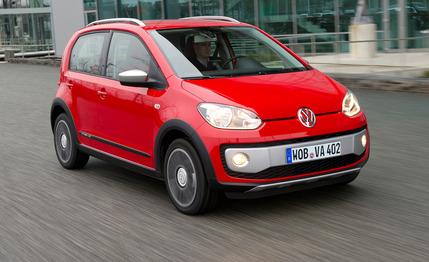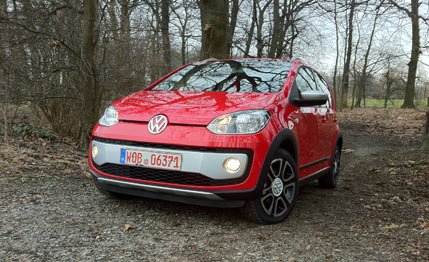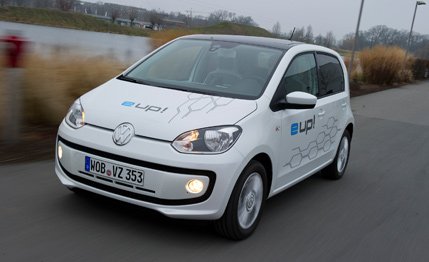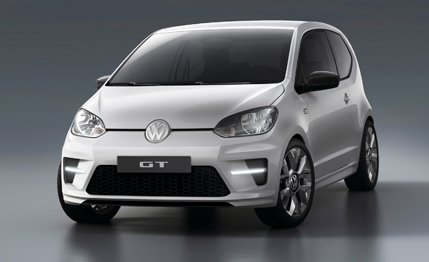 Prototype Drive
Prototype Drive
The Volkswagen Up! family is growing rapidly. The three- and five-door Up! models and two rebadged versions—the SEAT Mii and the Škoda Citigo—are already officially out the door, and a flurry of concept cars at the Frankfurt auto show last September promised further spin-offs. At the reveal event for the five-door Up!, VW provided seat time in some of the additional variants planned for production. (Reminder: No Up! model is planned for the U.S. Let’s be sad together.)

Cross Up!: With dark charcoal fenders; silver roof rails, mirrors, and bumpers; and a larger front air intake, the Cross Up! is the tough(-ish) guy in this small-car family. The only notable chassis tweak involved in its creation was an extra inch of ground clearance that makes the body roll inherent to the regular three-door model worse. With no powertrain enhancements—we drove it with the 75-hp version of the Up!’s three-cylinder—it’s also as slow as the three-door, although we do like that the comfortable ride is retained. Being front-wheel drive and incorporating no beefed-up components, off-road chops are nonexistent. So it's a poseur, albeit a handsome one. Inside, the Cross Up! gets its own red and gray seat trim and a piano-black finish on the center console. We wish VW would have gone more extreme with the interior and suspension lift in the vein of the Golf Country, which was based on the all-wheel-drive version of the Mark II Golf.

E-Up!: A fully electric Up! will go on sale by 2013. This prototype is powered by a front-mounted electric motor that sends 80 hp and 155 lb-ft of torque to the front wheels through a single-speed transmission; this setup should carry through to production. The E-Up! launches with some alacrity from a stop, but it begins to lose steam above 45 or so mph and, according to VW, takes almost 14 seconds to reach 60 mph. We hit the car’s speed ceiling at 80 mph. The E-Up!’s range is more than 90 miles; it takes 5.5 hours to recharge the 450-plus-pound battery pack using a European 220-volt household outlet.
The components are scalable, and the E-Up!’s electric motor is related to the 115-hp unit in the electric Golf blue-e-motion. The same goes for the smaller car’s transmission, which is beefed up for duty in the Golf. The battery pack is mounted under the floor between the front seats and rear axle; as a result, the floor is raised slightly, but the trunk space remains untouched. The intensity of the motor/generator’s energy recuperation can be set to one of three levels. In the most aggressive setting, the E-Up! decelerates so forcefully that the brake lights activate. It is not yet clear whether VW will sell the production car with such a setup.
The driving experience is similar to that of any electric vehicle we’ve driven thus far. There’s some faint electric powertrain whine, mostly silence from everything else and, despite lively off-the-line acceleration, an overwhelming feeling of heft. But the absence of squeaks, rattles, and excessive road and wind noise was impressive, especially given the E-Up!’s preproduction form.

Up! GT: This one was our favorite of the three that we drove. It’s a pocket rocket essentially created by turbocharging and intercooling the Up!’s EA211 1.0-liter, three-cylinder powerplant. It adds a new cylinder head with direct injection, and power is boosted from the naturally aspirated engine’s maximum output from 75 hp to 110 hp. (A 60-hp version of the three is also available in the Up!.) At speed, the Up! GT emits a pleasant, sonorous sound that is typical of more powerful three-cylinder cars and reminds this author of the late-1980s Daihatsu Charade GTti, which is sort of a cult model in Europe and Asia. Maximum torque is 129 lb-ft and is transmitted to the front wheels through a six-speed manual transmission. The GT will be the only Up! to get this particular gearbox, which is internally designated MQ200. Lesser Up! models get a five-speed transmission in traditional stick-shift or single-clutch-automatic form.
Almost everything about the Up! GT is satisfying, from the firmer suspension to the linear power delivery with only slight turbo lag. We hit 125 mph around Wolfsburg. The brakes—discs up front, drums at the rear—are strong enough for the car, which is claimed to weigh less than a ton. We would prefer an even sportier suspension setup and more steering feedback, but this prototype shows great potential. It’s not quite clear what it will look like when it comes to market in late 2013. The front fascia of the concept looks generic, and a designer tells us it likely will be restyled before the car rolls off an assembly line. We’d figure on some new badges, too, as the prototype carries no indication of its force-fed powertrain. Speaking of badges, since this car is exactly as powerful as the first Golf GTI and weighs only slightly more, why not go ahead and call it a GTI? VW’s most iconic performance nameplate could come full circle.
When we first drove the Up!, we noted its slowness and its substantial body roll but also its potential for improvement. It’s clear from these prototypes that the car’s promise is closer to being fulfilled. And let’s hope VW reconsiders offering the Up! in the U.S. We would certainly give the GT in particular a warm welcome.